 W
WThe Book of Revelation is the final book of the New Testament, and consequently is also the final book of the Christian Bible. Its title is derived from the first word of the Koine Greek text: apokalypsis, meaning "unveiling" or "revelation." The Book of Revelation is the only apocalyptic book in the New Testament canon. Thus, it occupies a central place in Christian eschatology.
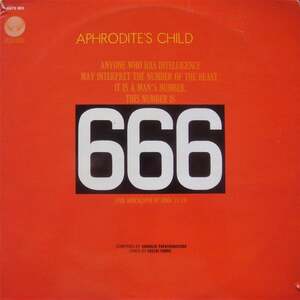 W
W666 is a double album by psychedelic/progressive rock group Aphrodite's Child, released in 1972. Ostensibly an adaptation of Biblical passages from the Book of Revelation, the album is the most critically acclaimed Aphrodite's Child album. It was also the group's last album, due to internal tensions during the recording process and conflict with the record company. By the time it was released, the band had already disbanded and its members begun working on solo projects.
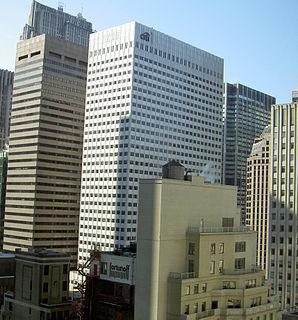 W
W666 Fifth Avenue is a 41-story office building on Fifth Avenue between 52nd and 53rd Streets in Midtown Manhattan, New York City. The office tower was designed by Carson & Lundin and built in 1957.
 W
WThe Hebrew term "Abaddon", and its Greek equivalent "Apollyon" appear in the Bible as both a place of destruction and an archangel of the abyss. In the Hebrew Bible, abaddon is used with reference to a bottomless pit, often appearing alongside the place שְׁאוֹל (Sheol), meaning the realm of the dead.
 W
WAlpha and omega are the first and last letters of the Greek alphabet, and a title of Christ and God in the Book of Revelation. This pair of letters is used as a Christian symbol, and is often combined with the Cross, Chi-rho, or other Christian symbols.
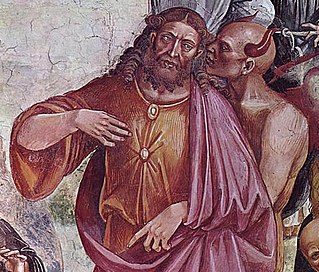 W
WIn Christian eschatology, the Antichrist, or anti-Christ, is a person prophesied by the Bible to oppose Christ and substitute himself in Christ's place before the Second Coming. The term is found five times in the New Testament, solely in the First and Second Epistle of John. The Antichrist is announced as the one "who denies the Father and the Son."
 W
WAccording to Eastern Orthodox traditions, according to the Commentary on the Apocalypse of Andreas of Caesarea, believe Saint Antipas to be the Antipas referred to in the Book of Revelation, Revelation 2:13, as the verse says: "I know thy works, and where thou dwellest, even where Satan's seat is: and thou holdest fast my name, and hast not denied my faith, even in those days wherein Antipas was my faithful martyr, who was slain among you, where Satan dwelleth." According to Christian tradition, John the Apostle ordained Antipas as bishop of Pergamon during the reign of the Roman emperor Nero. The traditional account goes on to say Antipas was martyred during the reign of Nero (54-68), by burning in a brazen bull-shaped altar for casting out demons worshiped by the local population.
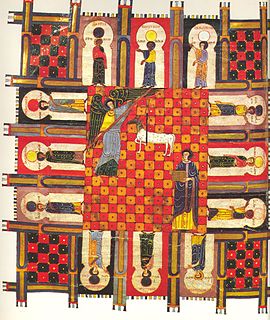 W
WAquarius is an opera for eight sopranos, eight baritones, and orchestra by Karel Goeyvaerts. It was begun in 1983 and completed in April 1992, to a libretto by the composer in eight languages, incorporating lines from the Revelation of St. John.
 W
WAccording to the Book of Revelation in the New Testament of the Christian Bible, Armageddon is the prophesied location of a gathering of armies for a battle during the end times, which is variously interpreted as either a literal or a symbolic location. The term is also used in a generic sense to refer to any end of the world scenario. In Islamic theology, the Armageddon is also mentioned in Hadith as the Greatest Armageddon or Al-Malhama Al-Kubra.
 W
WBalak was a king of Moab described in the Book of Numbers in the Hebrew Bible, where his dealings with the prophet Balaam are recounted. Balak tried to engage Balaam for the purpose of cursing the migrating Israelite community. On his journey to meet the princes of Moab, Balaam is stopped by an angel of the lord after beating his donkey. He tells the angel he will return home: "I have sinned, for I did not know that you stood against me on the road". The angel instructs Balaam to attend the meeting with the princes of Moab but to "say only what I tell you". According to Numbers 22:2, and Joshua 24:9, Balak was the son of Zippor.
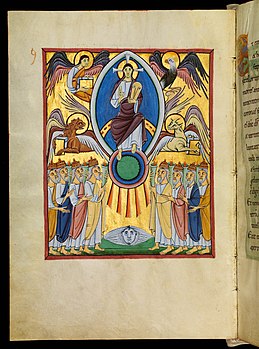 W
WThe Bamberg Apocalypse is an 11th-century richly illuminated manuscript containing the pictorial cycle of the Book of Revelation and a Gospel Lectionary of the books of pericopes. This medieval illuminated manuscript was created during the Ottonian dynasty; it is unknown whether it was commissioned by Otto III or Henry II. It was completed sometime between 1000 and 1020. There is proof that Henry II donated this illuminated manuscript in 1020 to Collegiate Abbey of St. Stephan, on the occasion of its inauguration. The Bamberg Apocalypse is now located in the Bamberg State Library.
 W
WThe Beast may refer to one of two beasts described in the Book of Revelation.
 W
WSaint Beatus of Liébana was a monk, theologian, and geographer from the former Duchy of Cantabria and Kingdom of Asturias, in modern Cantabria, northern Spain, who worked and lived in the Picos de Europa mountains of the region of Liébana. He is best remembered today as the author of the Commentary on the Apocalypse.
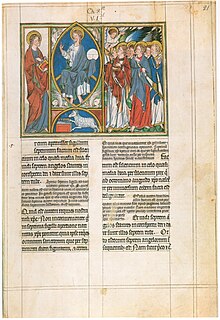 W
WBerengaudus (840–892) was a Benedictine monk, supposed author of Expositio super septem visiones libri Apocalypsis, a Latin commentary on the Book of Revelation. He has traditionally been assumed to be a monk of Ferrières Abbey, at the time of Lupus Servatus. The attribution has been questioned, but the Expositio was later much circulated in manuscript. It was printed in Patrologia Latina vol. XVII under Ambrose, following an attribution by Cuthbert Tunstall.
 W
WIn Christianity and Judaism, the Book of Life is the book in which God records the names of every person who is destined for Heaven or the World to Come. According to the Talmud it is open on Rosh Hashanah, as is its analog for the wicked, the Book of the Dead. For this reason extra mention is made for the Book of Life during Amidah recitations during the Days of Awe, the ten days between Rosh Hashanah, the Jewish new year, and Yom Kippur, the day of atonement.
 W
WThe Cave of the Apocalypse is situated about halfway up the mountain on the Aegean island of Patmos, along the road between the villages of Chora and Skala. This grotto is believed to mark the spot where John of Patmos received his visions that he recorded in the Book of Revelation. In 1999, UNESCO declared the cave a joint World Heritage Site together with the Monastery of Saint John the Theologian.
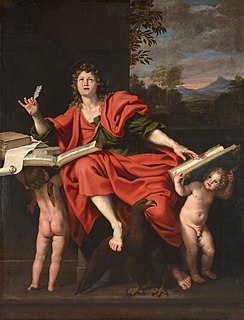 W
WThe events of Revelation are the events that occur in the Book of Revelation of the New Testament. An outline follows below, chapter by chapter.
 W
WIn religion, a false prophet is a person who falsely claims the gift of prophecy or divine inspiration, or to speak for God, or who makes such claims for evil ends. Often, someone who is considered a "true prophet" by some people is simultaneously considered a "false prophet" by others, even within the same religion as the "prophet" in question. In a wider sense, it is anyone who, without having it, claims a special connection to the Deity and sets him or herself up as a source of spirituality, as an authority, preacher, or teacher. Analogously, the term is sometimes applied outside religion to describe someone who fervently promotes a theory that the speaker thinks is false.
 W
WThe Four Horsemen of the Apocalypse are figures in Christian faith, appearing in the New Testament's final book, Revelation, an apocalypse written by John of Patmos, as well as in the Old Testament's prophetic Book of Zechariah, and in the Book of Ezekiel, where they are named as punishments from God.
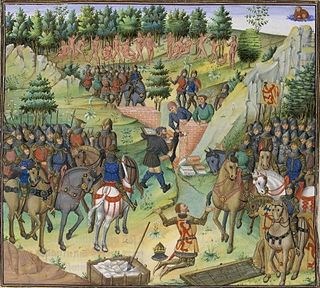 W
WGog and Magog appear in the Hebrew Bible and Quran as individuals, tribes, or lands. In Ezekiel 38, Gog is an individual and Magog is his land; in Genesis 10 Magog is a man, but no Gog is mentioned; and centuries later Jewish tradition changed Ezekiel's "Gog from Magog" into "Gog and Magog", which is the form in which they appear in the Christian New Testament's Book of Revelation, although there they are peoples rather than individuals.
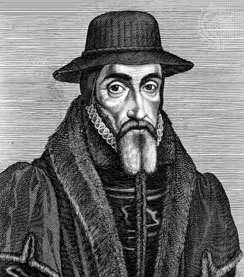 W
WThe English Protestant cleric John Foxe of the 16th century, known primarily if somewhat misleadingly as a martyrologist on the basis of his major work Actes and Monuments, wrote also on the interpretation of the Apocalypse, both at the beginning of his writing career in the 1550s, and right at the end of it, with his Eicasmi of 1587, the year of his death.
 W
WJohn of Patmos could be the author named as John in the Book of Revelation, the apocalyptic text forming the final book of the New Testament. The text of Revelation states that John was on Patmos, a Greek island where, by most biblical historians, he is considered to have been exiled as a result of anti-Christian persecution under the Roman emperor Domitian.
 W
WJohn the Apostle was one of the Twelve Apostles of Jesus according to the New Testament. Generally listed as the youngest apostle, he was the son of Zebedee and Salome. His brother was James, who was another of the Twelve Apostles. The Church Fathers identify him as John the Evangelist, John of Patmos, John the Elder and the Beloved Disciple, and testify that he outlived the remaining apostles and that he was the only one to die of natural causes. The traditions of most Christian denominations have held that John the Apostle is the author of several books of the New Testament.
 W
WJohn's vision of the Son of Man is a vision described in the Book of Revelation in which the author, identified as John, sees a person he describes as one "like the Son of Man". The Son of Man is portrayed in this vision as having a robe with a golden sash, white hair, eyes like blazing fire, feet like bronze and a voice like rushing waters. He holds seven stars in his right hand and has a double-edged sword coming out of his mouth. The vision is interpreted by Christians as the only identifiable physical description of Jesus in any form in the Christian biblical canon.
 W
WThe Last Judgment or The Day of the Lord is part of the eschatological world view of the Abrahamic religions and in the Frashokereti of Zoroastrianism.
 W
WMagog is the second of the seven sons of Japheth mentioned in the Table of Nations in Genesis 10.
 W
WThe New Earth is an expression used in the Book of Isaiah, 2 Peter (3:13), and the Book of Revelation (21:1) in the Bible to describe the final state of redeemed humanity. It is one of the central doctrines of Christian eschatology and is referred to in the Nicene Creed as the world to come.
 W
WIn the Book of Ezekiel in the Hebrew Bible, New Jerusalem is Ezekiel's prophetic vision of a city centered on the rebuilt Holy Temple, the Third Temple, to be established in Jerusalem, which would be the capital of the Messianic Kingdom, the meeting place of the twelve tribes of Israel, during the Messianic era. The prophecy is recorded by Ezekiel as having been received on Yom Kippur of the year 3372 of the Hebrew calendar.
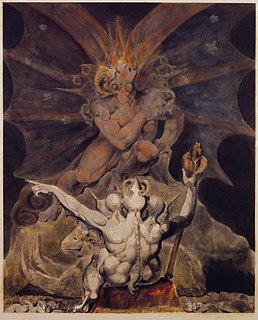 W
WThe number of the beast is associated with the Beast of Revelation in chapter 13, verse 18 of Book of Revelation. In most manuscripts of the New Testament and in English translations of the Bible, the number of the beast is six hundred and sixty-six or χξϛ. Papyrus 115, as well as other ancient sources like Codex Ephraemi Rescriptus, give the number of the beast as χιϛ or χιϲ, not 666; critical editions of the Greek text, such as the Novum Testamentum Graece, note 616 as a variant.
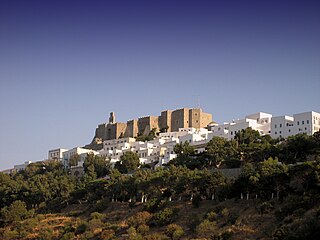 W
WPatmos is a small Greek island in the Aegean Sea. It is perhaps best known today as the location the disciple / apostle John received the visions found in the Book of Revelation of the New Testament, and where the book was written.
 W
WPearly gates is an informal name for the gateway to Heaven according to some Christian denominations. It is inspired by the description of the New Jerusalem in Revelation 21:21: "The twelve gates were twelve pearls, each gate being made from a single pearl."
 W
WThe seven bowls are a set of plagues mentioned in Revelation 16. They are recorded as apocalyptic events that were seen in the vision of the Revelation of Jesus Christ, by John of Patmos. Seven angels are given seven bowls of God's wrath, each consisting of judgements full of the wrath of God. These seven bowls of God's wrath are poured out on the wicked and the followers of the Antichrist after the sounding of the seven trumpets.
 W
WThe Seven Churches of Revelation, also known as the Seven Churches of the Apocalypse and the Seven Churches of Asia, are seven major churches of Early Christianity, as mentioned in the New Testament Book of Revelation. All of them are located in Asia Minor, present-day Turkey.
 W
WIn the Book of Revelation, the Seven Seals of God are the seven symbolic seals that secure the book or scroll that John of Patmos saw in an apocalyptic vision. The opening of the seals of the document occurs in Revelation Chapters 5–8 and marks the Second Coming of the Christ and the beginning of The Apocalypse. In John's vision, the only one worthy to open the book/scroll is referred to as both the "Lion of Judah" and the "Lamb having seven horns and seven eyes".
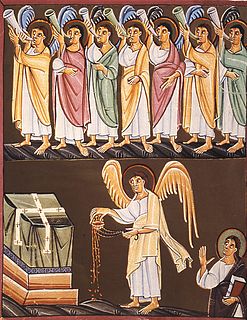 W
WIn the Book of Revelation, seven trumpets are sounded, one at a time, to cue apocalyptic events seen by John of Patmos in his vision. The seven trumpets are sounded by seven angels and the events that follow are described in detail from Revelation Chapters 8 to 11. According to Revelation 8:1–2 the angels sound these trumpets after the breaking of the seventh seal. These seals secured the apocalyptic document held in the right hand of Him who sits on the throne. The trumpets are referred to in Koine Greek as σάλπιγξ ; this was a straight, narrow bronze tube with a mouthpiece of bone and a bell; they do not resemble modern trumpets. The final three trumpets are sometimes called the "woe trumpets".
 W
W"Supper's Ready" is a song by the band Genesis. A recorded version appeared on their 1972 album Foxtrot, and the band performed the song regularly on stage for several years following this. Live versions appear on the albums Live at the Rainbow recorded in 1973, Seconds Out recorded in 1977, the compilation Genesis Archive 1967–75, and the box set Genesis Live 1973–2007. A reworked version also appears on Steve Hackett's 2012 album Genesis Revisited II and its accompanying live albums Genesis Revisited: Live at Hammersmith and Genesis Revisited: Live at Royal Albert Hall.
 W
WTextual variants in the Book of Revelation are the subject of the study called textual criticism of the New Testament. Textual variants in manuscripts arise when a copyist makes deliberate or inadvertent alterations to a text that is being reproduced. An abbreviated list of textual variants in this particular book is given in this article below.
 W
WThe "three angels' messages" is an interpretation of the messages given by three angels in Revelation 14:6–12. The Seventh-day Adventist church teaches that these messages are given to prepare the world for the second coming of Jesus Christ, and sees them as a central part of its own mission.
 W
WThe tree of life is a term mentioned in the Hebrew Bible.
 W
WIn the Book of Revelation, the two witnesses are two of God's prophets who are seen by John of Patmos, during the "Second woe" recorded in Revelation 11:1-14. They have been variously identified by theologians as two people, as two groups of people, or as two concepts. Dispensationalist Christians believe that the events described in the Book of Revelation will occur before and during the Second Coming. The two witnesses are never identified in the Christian Bible. Some believe they are Enoch and Elijah. as in the Gospel of Nicodemus, since they are the only two that did not see death as required by the Scriptures. Others believe them to be Moses and Elijah because they appeared during the transfiguration of Jesus, or because Enoch was not Abraham's descendant. Some also believe that they are Moses and Elijah due to the description of what they are to do. They have the power to shut the heavens (Elijah) and turn water into blood (Moses)
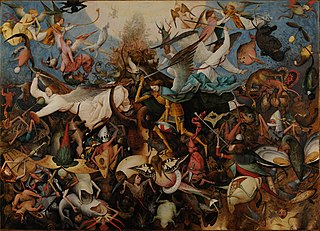 W
WThe Book of Revelation describes a war in heaven between angels led by the Archangel Michael against those led by "the dragon", identified as the devil or Satan, who will be defeated and thrown down to the earth. Revelation's war in heaven is related to the idea of fallen angels, and possible parallels have been proposed in the Hebrew Bible and the Dead Sea Scrolls.
 W
WIn Christianity the term "water of Life" is used in the context of living water, specific references appearing in the Book of Revelation, as well as the Gospel of John. In these references, the term Water of Life refers to the Holy Spirit. Ὕδωρ ζωῆς is a metaphor with two meanings: literally “flowing water” as in a river, and figuratively “living water.” “Whereas ordinary water sustains life for a while, the water God provides gives life forever.
 W
WBabylon the Great, commonly known as the Whore of Babylon, refers to both a symbolic female figure and place of evil mentioned in the Book of Revelation in the Bible. Her full title is stated in Revelation 17 as Mystery, Babylon the Great, the Mother of Prostitutes and Abominations of the Earth.
 W
WThe Woman of the Apocalypse is a figure described in Chapter 12 of the Book of Revelation.